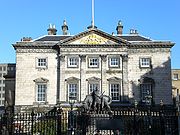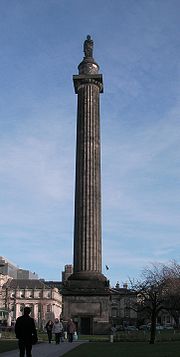
St. Andrew Square
Encyclopedia

George Street, Edinburgh
Situated to the north of Princes Street, George Street is a major street in the centre of Edinburgh, the capital of Scotland. Laid out from 1767 as part of James Craig's plan for the New Town, George Street was named in honour of King George III.-Geography:...
. The construction of St. Andrew Square began in 1772, as the first part of the New Town
New Town, Edinburgh
The New Town is a central area of Edinburgh, the capital of Scotland. It is often considered to be a masterpiece of city planning, and is a UNESCO World Heritage Site...
, designed by James Craig
James Craig (architect)
James Craig was a Scottish architect. His brief career was concentrated almost entirely in Edinburgh, and he is remembered primarily for his layout of the first Edinburgh New Town.-Date of birth:...
. Within six years of its completion St. Andrew Square became one of the most desirable and most fashionable residential areas in the city. As the 19th century came to a close, St. Andrew Square evolved into the commercial centre of the city.
Today, housing in St. Andrew Square is restricted to the northern side of the square. Its gardens are now surrounded all day by buses and crowded walkways. Most of the rest of the square is made up of major offices of banks and insurance companies, making it one of the major financial centers in Scotland. St. Andrew Square claims to be the richest area of its size in the whole of Scotland.
Points of interest

Henry Dundas, 1st Viscount Melville
Henry Dundas, 1st Viscount Melville PC and Baron Dunira was a Scottish lawyer and politician. He was the first Secretary of State for War and the last person to be impeached in the United Kingdom....
, the first viscount Melville. The Melville Monument is surrounded by the beautiful St. Andrew Square Gardens.
On the east side of the square stands the impressive mansion of Dundas House
Dundas House
Dundas House is located at 36 St Andrew Square, Edinburgh, Scotland. It is the Registered Office of the Royal Bank of Scotland. It is protected as a category A listed building....
, built by Sir William Chambers for Sir Lawrence Dundas between 1772 and 1774. Once the intended site for St. Andrew's Church
St Andrew's and St George's Church
St Andrew's and St George's West Church serves Edinburgh's New Town, in Scotland. It is a congregation of the Church of Scotland. The parish today constitutes the whole of the First New Town of Edinburgh and a small part of the early 19th century Second New Town of Edinburgh...
, Dundas House became the head office of The Royal Bank of Scotland in 1825. Architectural features of Dundas House are represented today on the "Ilay" series of banknotes issued by the Royal Bank; the building's Palladian
Palladian architecture
Palladian architecture is a European style of architecture derived from the designs of the Venetian architect Andrea Palladio . The term "Palladian" normally refers to buildings in a style inspired by Palladio's own work; that which is recognised as Palladian architecture today is an evolution of...
facade features on the obverse of each note, and the background graphic on both sides of the notes is a radial star design
Firmament
The firmament is the vault or expanse of the sky. According to Genesis, God created the firmament to separate the oceans from other waters above.-Etymology:...
which is based on the ornate ceiling of the banking hall inside Dundas House, designed by John Dick Peddie
John Dick Peddie
John Dick Peddie was a Scottish architect, businessman and a Liberal Party politician.-Biography:John Dick Peddie and his twin brother William were the second and third sons of James Peddie WS and Margaret Dick...
in 1857.
A short distance from Dundas House, down George Street, is where St. Andrew’s Church was built in 1784. In 1806 the head office of the British Linen Bank
British Linen Bank
The British Linen Bank was a commercial bank based in Edinburgh, Scotland. It was acquired by the Bank of Scotland in 1969 and served as the Bank's merchant bank arm from 1977 until 1999.-Foundation:...
moved to St. Andrew Square, where the offices of the printers and publishers still occupy the building. St. Andrew Square was also home to the National Bank of Scotland
National Bank of Scotland
The National Bank of Scotland Ltd. was a Scottish commercial bank. It was founded in 1825, and obtained a royal charter in 1831. It became the first Scottish bank to open a London office, in 1864...
, which was headquartered at no.42, until it merged with the Royal Bank of Scotland
Royal Bank of Scotland
The Royal Bank of Scotland Group is a British banking and insurance holding company in which the UK Government holds an 84% stake. This stake is held and managed through UK Financial Investments Limited, whose voting rights are limited to 75% in order for the bank to retain its listing on the...
in 1969.
St. Andrew Square is also home to the Stock Exchange and many of the principle insurance offices, such as the Edinburgh, the Standard, the Royal, and the Prudential.
Notable residents
Many famous Scots occupied the residences of St. Andrew Square. On the north side of the square, No. 21 was the birthplace of Lord Henry Brougham in 1778. His family was one of the first families to take up residency in St. Andrew Square. Another resident was philosopher and economist David HumeDavid Hume
David Hume was a Scottish philosopher, historian, economist, and essayist, known especially for his philosophical empiricism and skepticism. He was one of the most important figures in the history of Western philosophy and the Scottish Enlightenment...
, friend of architect Robert Adam
Robert Adam
Robert Adam was a Scottish neoclassical architect, interior designer and furniture designer. He was the son of William Adam , Scotland's foremost architect of the time, and trained under him...
. Hume was persuaded to move to St. Andrew Square by Adam with the hopes that the recruitment of such a powerful person would induce others to cross from the Old Town
Old Town, Edinburgh
The Old Town of Edinburgh, the capital of Scotland, is the medieval part of the city. Together with the 18th-century New Town, it is a UNESCO World Heritage Site. It has preserved its medieval plan and many Reformation-era buildings....
to the New Town and St. Andrew Square. Hume chose a site on the southwest side of the square at the corner of Princes Street
Princes Street
Princes Street is one of the major thoroughfares in central Edinburgh, Scotland, UK, and its main shopping street. It is the southernmost street of Edinburgh's New Town, stretching around 1 mile from Lothian Road in the west to Leith Street in the east. The street is mostly closed to private...
and an unnamed street (later named St. David Street). Also on the north side, No. 26 was the home to architect Sir William Chambers.
Transport
St Andrew Square has been used as a transport hub for a number of years. The Edinburgh Bus StationEdinburgh Bus Station
Edinburgh Bus Station is the bus station serving central Edinburgh which opened in its present form in February 2003....
(formerly called St Andrew Square Bus Station), located to the east of the square, is served by long-distance bus services such as Scottish Citylink
Scottish Citylink
Scottish Citylink Coaches Ltd is a long distance express coach operator in Scotland and the Republic of Ireland . The company was formed as a subsidiary of Scottish Transport Group in June 1985...
and Stagecoach Fife. It was redeveloped in 2003 to incorporate a new luxury shopping street, Multrees Walk
Multrees Walk
Multrees Walk is a pedestrian shopping area off the east side of St. Andrew Square, Edinburgh, Scotland. Created in 2003 as part of a redevelopment, it links St Andrew Square and St James Shopping Centre and its shops sell luxury goods including clothing, stationery and handbags.-Multrees...
, and the Edinburgh branch of Harvey Nichols
Harvey Nichols
Harvey Nichols, founded in 1813, is an upmarket department store chain. Its original store is in London. Founded in 1813 as a linen shop, it sells many international brands of clothing for women and men, fashion accessories, beauty products, wine and food...
.
The square is to acquire a tram station
St Andrew Square tram stop
St Andrew Square tram stop is a planned Edinburgh Trams stops serving the Princes Street area of Edinburgh. The stop was intended to be one on the line from Edinburgh Airport to Newhaven, but when the planned network was truncated to a single route from the airport to the city centre it became the...
in (approximately) 2014 when the new Edinburgh Trams are expected to come into operation. This will be the nearest stop to Edinburgh Waverley railway station
Edinburgh Waverley railway station
Edinburgh Waverley railway station is the main railway station in the Scottish capital Edinburgh. Covering an area of over 25 acres in the centre of the city, it is the second-largest main line railway station in the United Kingdom in terms of area, the largest being...
and Edinburgh bus station. Trams will operate from St Andrew Square to Edinburgh Airport
Edinburgh Airport
Edinburgh Airport is located at Turnhouse in the City of Edinburgh, Scotland, and was the busiest airport in Scotland in 2010, handling just under 8.6 million passengers in that year. It was also the sixth busiest airport in the UK by passengers and the fifth busiest by aircraft movements...
, calling at thirteen intermediate stops. Much of the east side of St Andrew Square (including North St Andrew Street and South St Andrew Street) will be closed to traffic during 2012 to allow for tram construction work.

